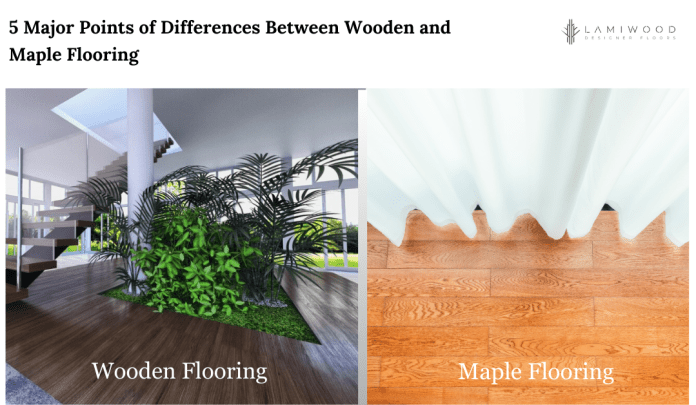Wooden flooring encompasses a broad range of materials and styles, each offering unique characteristics and benefits. Among the various types of wooden flooring, maple stands out for its distinctive features. This article highlights the key differences between general wooden flooring and maple flooring, helping you make an informed decision for your home or office.
- Wood Species Variety vs. Maple Specificity
General Wooden Flooring:
Wooden flooring is available in a wide variety of wood species, each offering different colors, grains, and hardness levels. Common choices include oak, walnut, cherry, hickory, and bamboo. This variety allows for a broader range of design options, catering to diverse aesthetic preferences and functional needs. Each species brings its unique characteristics, such as oak’s prominent grain or walnut’s deep, rich color.
Maple Flooring:
Maple flooring, on the other hand, is specific to the maple tree species. It is known for its consistent grain pattern and light, creamy color, which can range from pale white to light reddish-brown. Maple wood is particularly appreciated for its clean, smooth appearance and subtle grain, making it a popular choice for contemporary and minimalist interiors. The limited variety within maple flooring means less diversity in appearance compared to the broader category of wooden flooring.
- Hardness and Durability
General Wooden Flooring:
The hardness of wooden flooring can vary significantly depending on the wood species. For example, oak and hickory are known for their high durability, making them suitable for high-traffic areas. Softer woods like pine are more prone to dents and scratches but offer a warm, rustic look. The Janka hardness test is often used to measure the resistance of different wood types to wear and denting.
Maple Flooring:
Maple is considered one of the harder domestic woods, scoring high on the Janka hardness scale. This makes maple flooring highly durable and resistant to scratches and dents, suitable for high-traffic areas like hallways, kitchens, and living rooms. Its hardness also makes it a popular choice for sports courts and dance floors, where durability and a smooth surface are crucial.
- Grain and Appearance
General Wooden Flooring:
The appearance of engineered wood flooring varies widely with the species. Oak features a prominent grain pattern, walnut offers a darker, more complex grain, and cherry provides a rich, reddish hue. The choice of wood can significantly influence the overall look of the flooring, from rustic and traditional to sleek and modern.
Maple Flooring:
Maple’s grain is typically smooth and subtle, with a uniform texture that lends itself to a clean and contemporary look. The lack of prominent grain patterns means that maple flooring often appears more consistent and sleek, which can be an advantage in modern or minimalist design schemes. Its light color also helps to brighten up spaces, making rooms feel larger and more open.
- Staining and Finishing
General Wooden Flooring:
Different wood species react uniquely to staining and finishing processes. Some woods, like oak, absorb stains well and can be easily customized to match a variety of interior decors. Darker woods like walnuts often require less staining due to their natural deep hues, while softer woods like pine might need more protective finishes to enhance durability.
Maple Flooring:
Maple is less porous than many other hardwoods, which means it can be more challenging to stain evenly. The wood’s tight grain can cause stains to appear blotchy if not applied carefully. However, when properly finished, maple’s natural light color can be beautifully highlighted with clear or light-toned finishes, showcasing its natural beauty and enhancing its durability.
- Cost and Availability
General Wooden Flooring:
The cost of wooden flooring varies widely depending on the species, quality, and availability of the wood. Exotic woods like Brazilian cherry or teak tend to be more expensive, while domestic woods like oak and pine are more affordable. Availability can also impact cost, with some species being more readily accessible than others.
Maple Flooring:
Maple is generally moderately priced compared to other hardwood options. Its widespread availability in North America makes it a cost-effective choice for many homeowners. While it may not be as inexpensive as some softer woods, its durability and aesthetic appeal provide good value for the investment.
Conclusion
Choosing between general wooden flooring and maple flooring involves considering several key factors, including wood species variety, hardness and durability, grain and appearance, staining and finishing capabilities, and cost and availability. While general wooden flooring offers a broader range of options and styles, maple flooring stands out for its durability, sleek appearance, and consistent quality. Understanding these differences will help you select the best flooring option to meet your aesthetic preferences and functional needs.
